This article was produced in collaboration with the USC Annenberg Center for Health Journalism’s 2025 Impact Fund for Reporting on Health Equity and Health Systems.
At Manzo Elementary School in Tucson, Arizona, fifth graders Mia Leyva and Glenn Brockman recently led a tour through their school garden. After noting the sweetness of their homegrown carrots, they enthusiastically dug their hands into compost teeming with worms and explained how it would help fertilize the vegetable seedlings in the greenhouse. They invited visitors to smell sprigs of mint and rosemary, showed off fresh eggs from the chicken coop and professed their love of kale. While some of the garden’s modest harvest will end up in the school cafeteria, nutrition experts say it offers something else of value: food literacy.
But this scene may become increasingly rare. Across the country, a cascade of federal funding cuts by the Trump administration and Republican lawmakers are dismantling the infrastructure that makes nutrition education programs possible and helps schools purchase local farm products for meal programs. The impact of cuts to farm-to-school programs isn’t distributed equally. Well-resourced school districts like Tucson Unified have reliable funding from district coffers and grants as well as established systems in place to continue their farm-to-school and food literacy programs. However, small or rural districts that may have one elementary, middle and a high school with one person overseeing food service will face new challenges.
“Those districts just got stretched a lot thinner,” said Jessie Gruner, director of policy and community innovations at Arizona’s Pinnacle Prevention, a nonprofit that advocates policy and programs for Arizona food system equity.
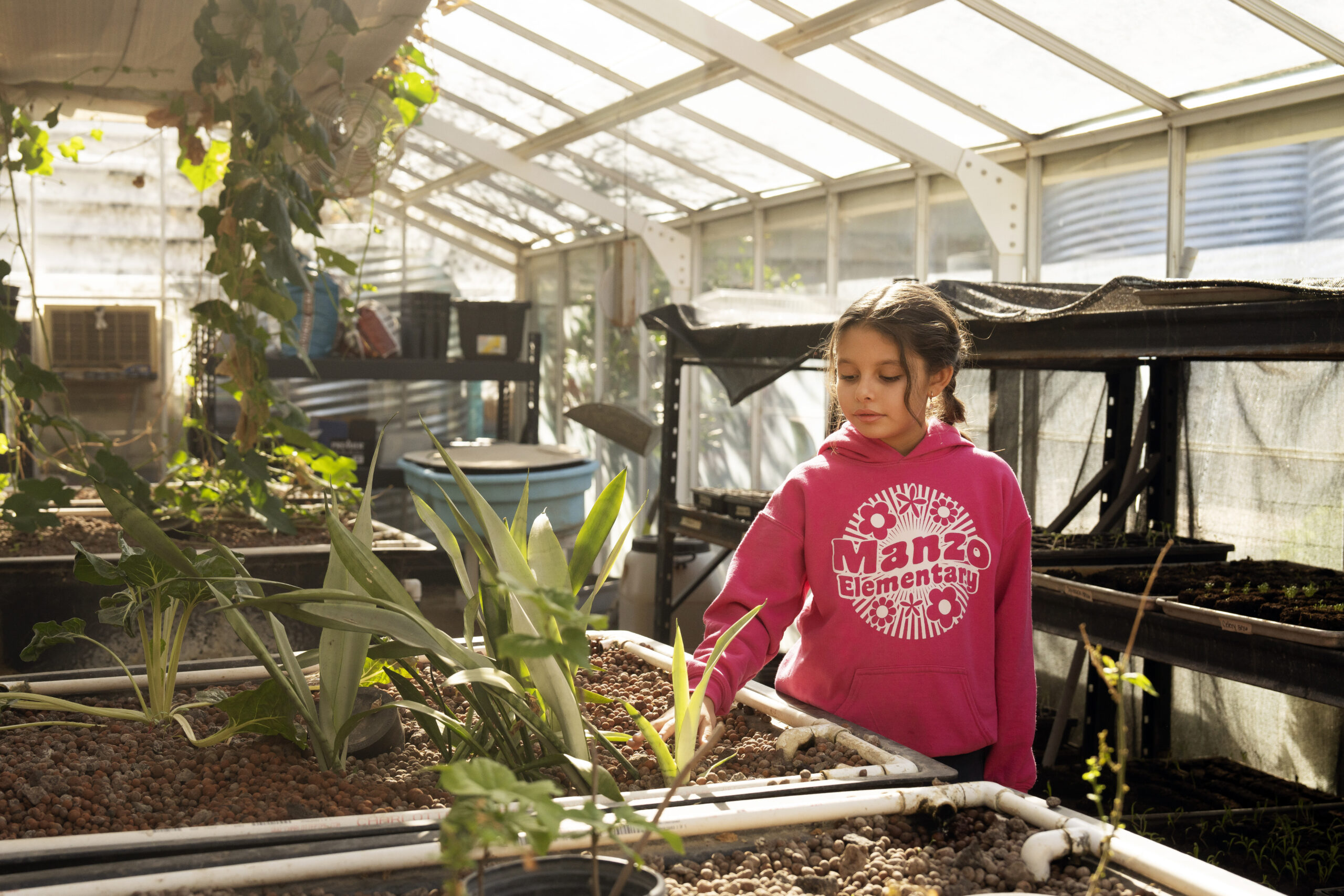
Mia Leyva, a fifth-grader at Manzo Elementary, gives a tour of the school greenhouse.
These cuts come at a time when American school children face an epidemic of diet-related illnesses. In Arizona and nationwide, about three in 10 children ages 10 to 17 are overweight or obese, which can lead to chronic health conditions like heart disease, high blood pressure and diabetes. Children who attend school in the Tucson Unified School District, like other kids in low-income communities, also lack access to safe places to exercise and affordable healthy food, often relying on ultraprocessed foods.
Public health advocates say the cuts come despite research demonstrating that children exposed to farm-to-school programs — like school gardens and nutrition education — eat more vegetables, are more willing to try new foods, exercise more and make healthier food choices.
The cuts began less than two months into President Trump’s second term, when the USDA abruptly canceled the Local Food Purchasing Assistance and the Local Food for Schools programs, which provided more than $1 billion to help schools and food banks buy produce, meat and dairy from local farms and ranches. Launched in 2021, these Biden administration programs offered relief to more than 40 states grappling with supply chain disruptions during the pandemic. The investment boosted longstanding farm-to-school programs and helped schools and local farmers build new relationships while enabling children to access fresh, healthy foods.
Capital & Main reached out to the U.S. Department of Agriculture for comment about the cuts, but did not hear back before publication. However, the USDA said in a March statement, published by Reuters and other publications, “These programs, created under the former Administration via Executive authority, no longer effectuate the goals of the agency.”
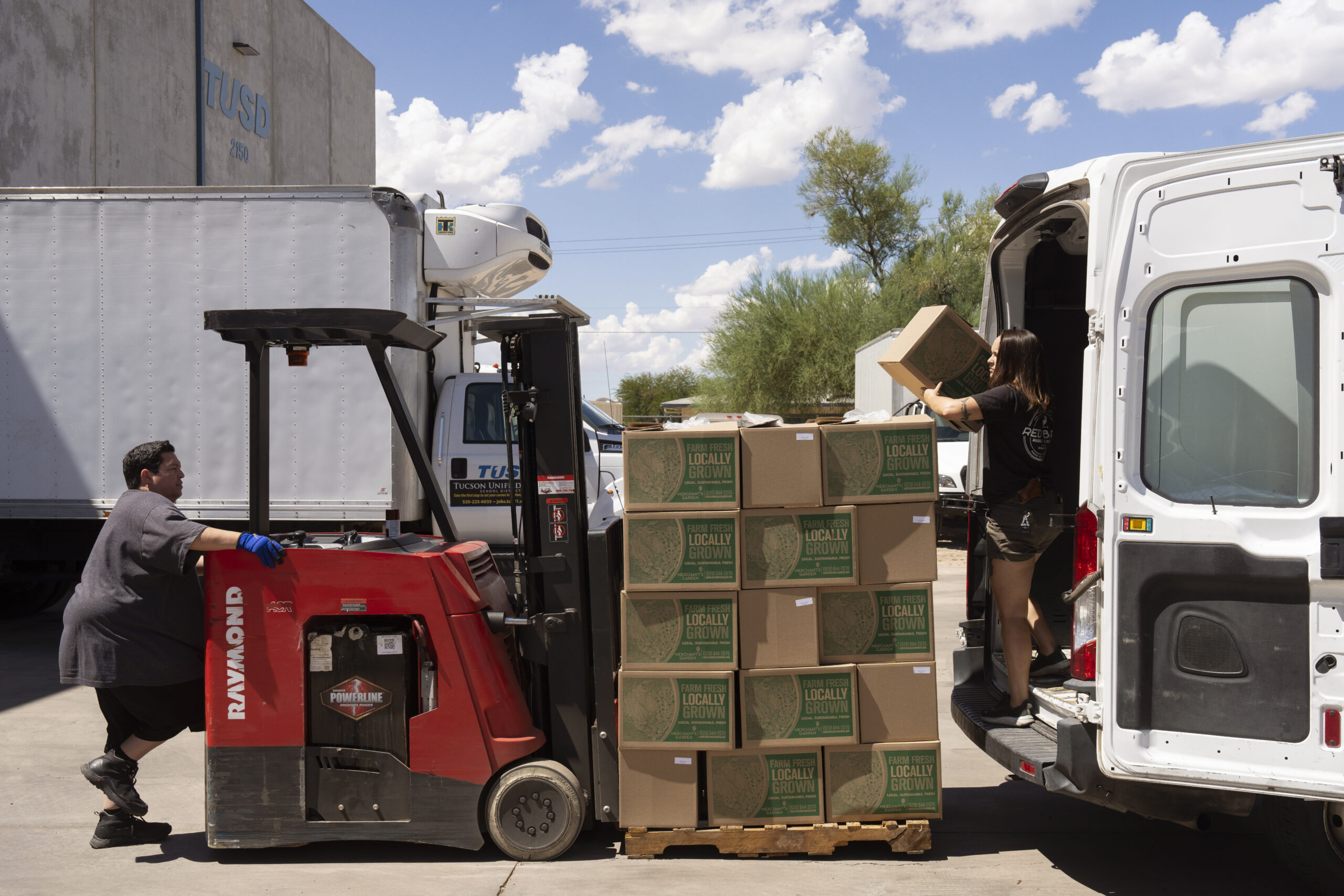
Carmen Nugent of Pivot Produce offloads boxes of locally grown lettuce at the Tucson Unified School District’s food warehouse.
These cancellations have handicapped effective food distribution pipelines that connect local agriculture to school cafeterias and foodbanks, said Audra Christophel, vice president of community development at the Community Food Bank of Southern Arizona. “There’s all this work that goes into building systems that help farmers increase their capacity so they build on past successes. Then to have them yanked back, it’s like, nevermind,” she explained. “That has an incredible impact on these farm businesses, family owned farms, and on those communities who are benefitting from really healthy, fresh, local food both through schools and emergency food distributors.”
The cuts come alongside another blow to school nutrition: Tens of thousands of children are expected to begin losing access to free school meals in October 2027, and some sooner, when they lose their SNAP eligibility. The One Big Beautiful Bill Act that President Trump signed in July, which Republicans in Congress passed over the universal opposition of Democrats, includes massive cuts to the Supplemental Nutrition Assistance Program, the nation’s largest food assistance program. And access to free school lunches is tied to SNAP eligibility. The Congressional Budget Office, Congress’ nonpartisan official scorekeeper, estimated that the cuts to SNAP will result in 96,000 kids losing free meals at school in a typical month as their families lose eligibility for SNAP.
Cuts to SNAP also mean the loss of educational dollars from SNAP-Ed, a decades-old program that, among other things, supports farm-to-school partnerships by linking farmers with schools, providing cooking classes and guiding districts through grants for kitchen and garden upgrades.
Research confirms that school meals are some of the healthiest, and most reliable, meals children eat. During a recent lunch period at Tucson High Magnet School, in a district with a Latino majority and where 60% of students qualify for free or reduced priced school meals, students chose from entrees including popular options like honey hot sauce chicken wings and a whole grain, low sodium ramen cup served with edamame. All entrees also came with a side of fresh vegetables from local farms served with a Greek yogurt ranch dip.
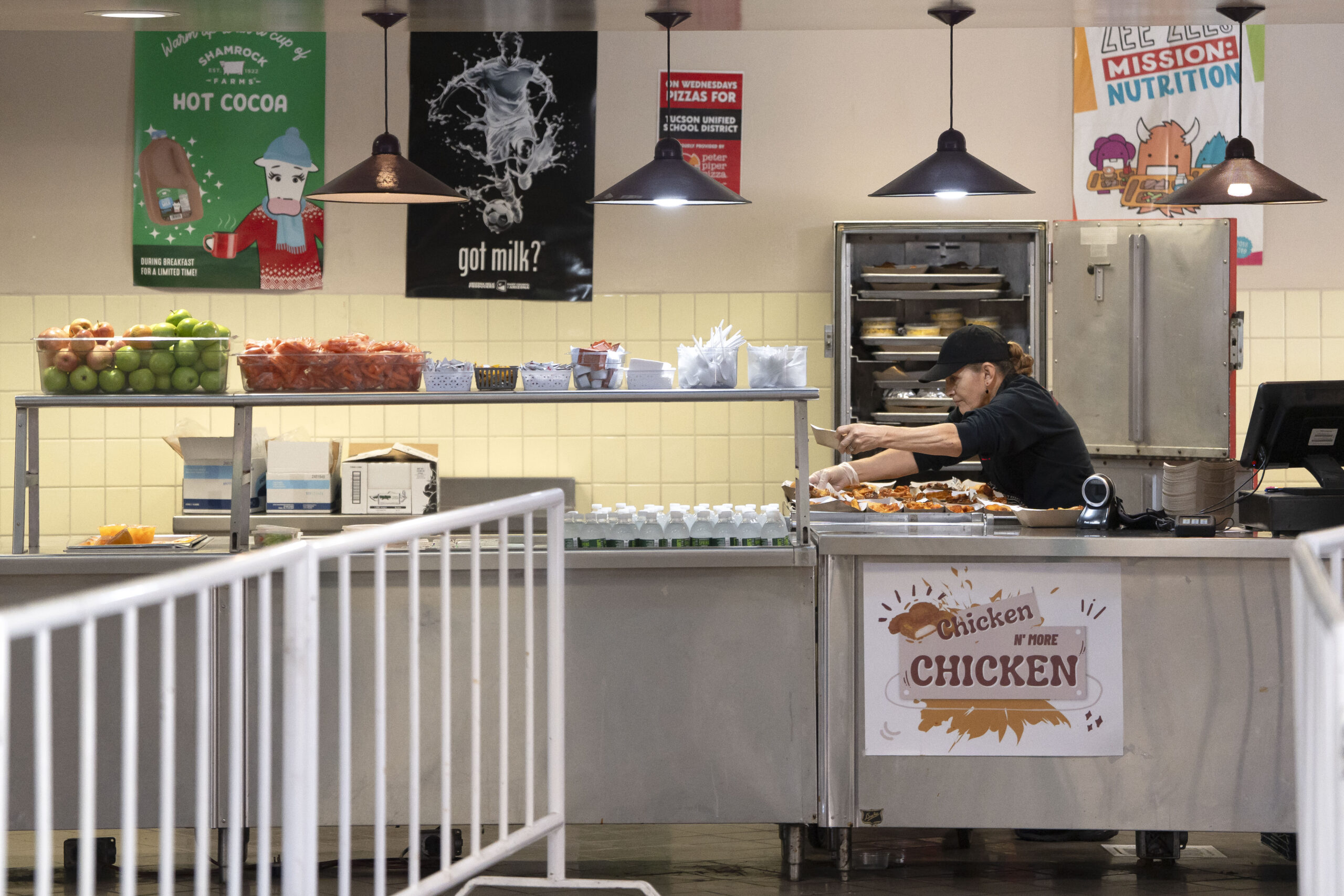
Kitchen staff prepare to serve the day’s lunch at Tucson High Magnet School.
“School lunch today is not like it was when we were kids,” said Lindsay Aguilar, food services director for the Tucson Unified School District, while standing in Tucson High Magnet School’s bustling cafeteria kitchen. She noted that meals now meet strict nutrition standards and often include locally sourced produce. “Healthier food at school is important,” Aguilar said, “but nutrition education, that’s where the investment should be, that’s how progress can be made, because learning gives kids the skills to eat healthier.”
School food has more benefits than just food security. It can help reduce rates of poor health, lower body mass index, as well as improve classroom behavior and reduce visits to the school nurse, according to research compiled by the Food Research & Action Center, a nonprofit organization that works to end poverty-related hunger in the United States.
For farmers who built their business models around selling to schools and food banks through these federal programs, the cuts have created immediate hardship.
Cindy Gentry helped found the Sunshine Produce Coop, which works with 40 farmers selling farm-fresh products to consumers as well as to schools and foodbanks across eight counties in and around Tempe, Arizona. Next February, the Coop will lose a $400,000 contract with the food banks selling their farmers’ produce. “The seeds had been ordered, equipment was purchased and now we have lost those sales for the farmers,” she said about the abrupt cancellation of the Local Food Purchasing Assistance funds.
As for the farm-to-school program, Gentry had been expanding. Sales of about $31,000 in 2023 had ballooned $278,000 last year. Now those gains, and the progress made getting fresh local produce into schools, is at risk.
One Tucson-area farmer, Bill Shriver, has been selling up to 100 cases of greens to the Tucson school district from his aquaponic and hydroponic farm, known as Merchant’s Garden. “I’ve built my business for 10 years on those sales,” he said. “Now those funds will be gone.”
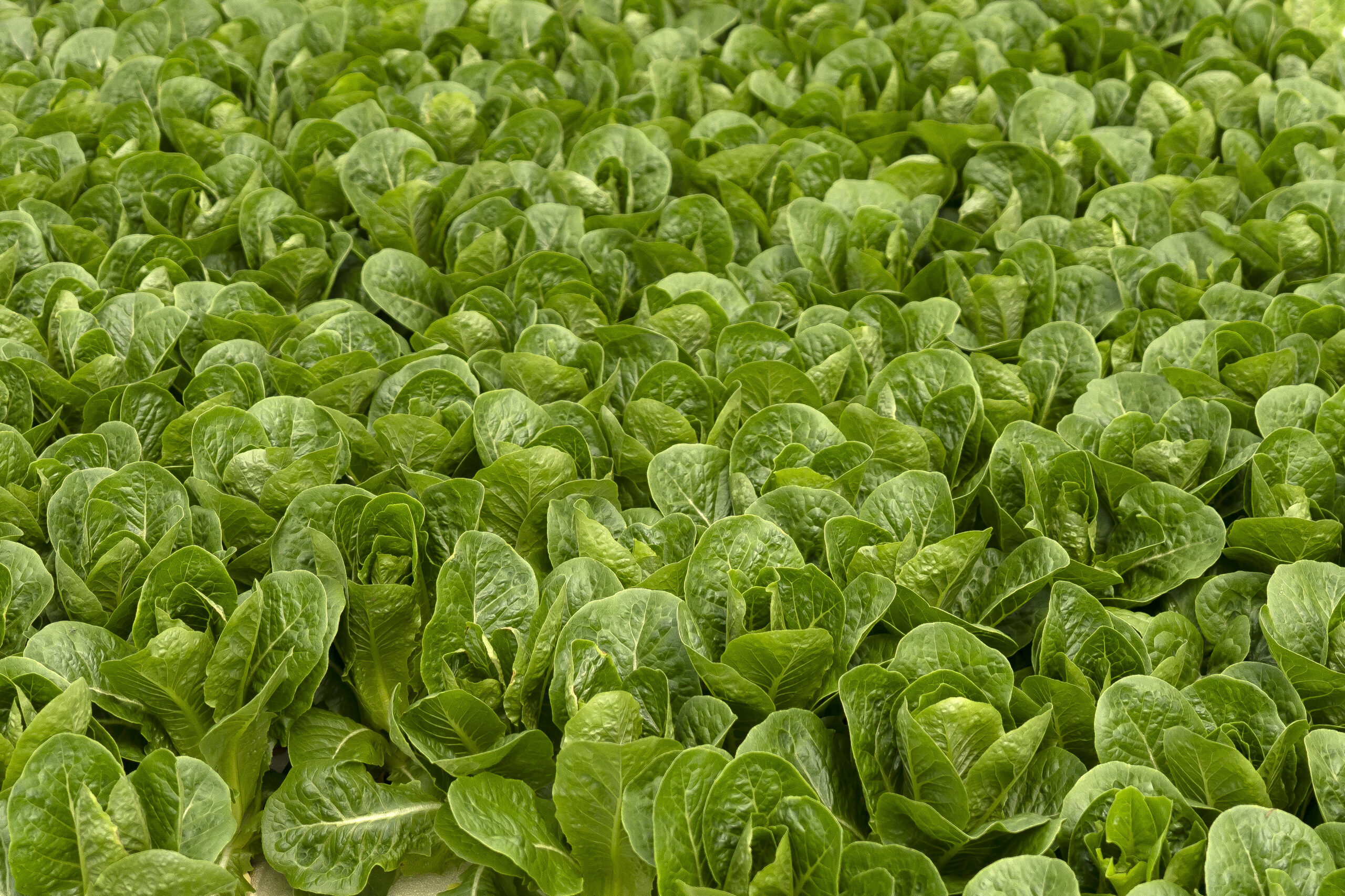
Lettuce grows at Merchant’s Garden in Tucson.
The cuts to farm-to-school programs are coming at a time when families already face significant challenges maintaining healthy diets due to high food prices and impending cuts to food assistance.
When children don’t have access to school meals, the alternatives are often nutritionally inadequate. Food service director Kim Sieck in Iowa’s Grinnell-Newburg School District said she’s seen students bring “three small candy bars and a bag of chips” as their lunch when school meals weren’t available to them.
Recently, the USDA touted the reinstatement of the Patrick Leahy Farm-to-School Grant program, which was cut in February along with the other farm-to-school programs. While advocates including Karen Spangler, policy director of the National Farm to School Network, said they’re happy to see the $18 million program funding released, she explained that only 10% of the funds can be spent on actual food purchases; the rest can be used for personnel, infrastructure and equipment.
“With all 50 states having lost their SNAP-Ed programs, competition for the [Patrick Leahy] farm-to-school grants is going to be tenfold because everyone is trying to fill up the void from the other cuts,” said Gruner of Pinnacle.
The impact of these cuts to food assistance will be increasingly hard to measure. Last month the USDA announced it will discontinue the Household Food Security Survey that’s been in place for 30 years. According to Katie Bergh, senior policy analyst at the Center on Budget and Policy Priorities, “The public will be losing our most consistent, most reliable, and a very long running data source that helps us understand the rate of food hardship in this country.”
For the fifth-graders tending their garden in Tucson, their love of kale might endure. But other students across the country may not get an opportunity to learn how food grows or develop a palate for fresh vegetables. “So much of our food choices are innate. We learn [eating habits] surrounded by our friends and our family. Our culture really shapes and forms our relationship with food at a very, very young age,” said Gruner, the food equity advocate from Arizona’s Pinnacle Prevention. “That’s why farm to school is so important. It really starts at the very beginning, nurturing that curiosity of where our food comes from.”
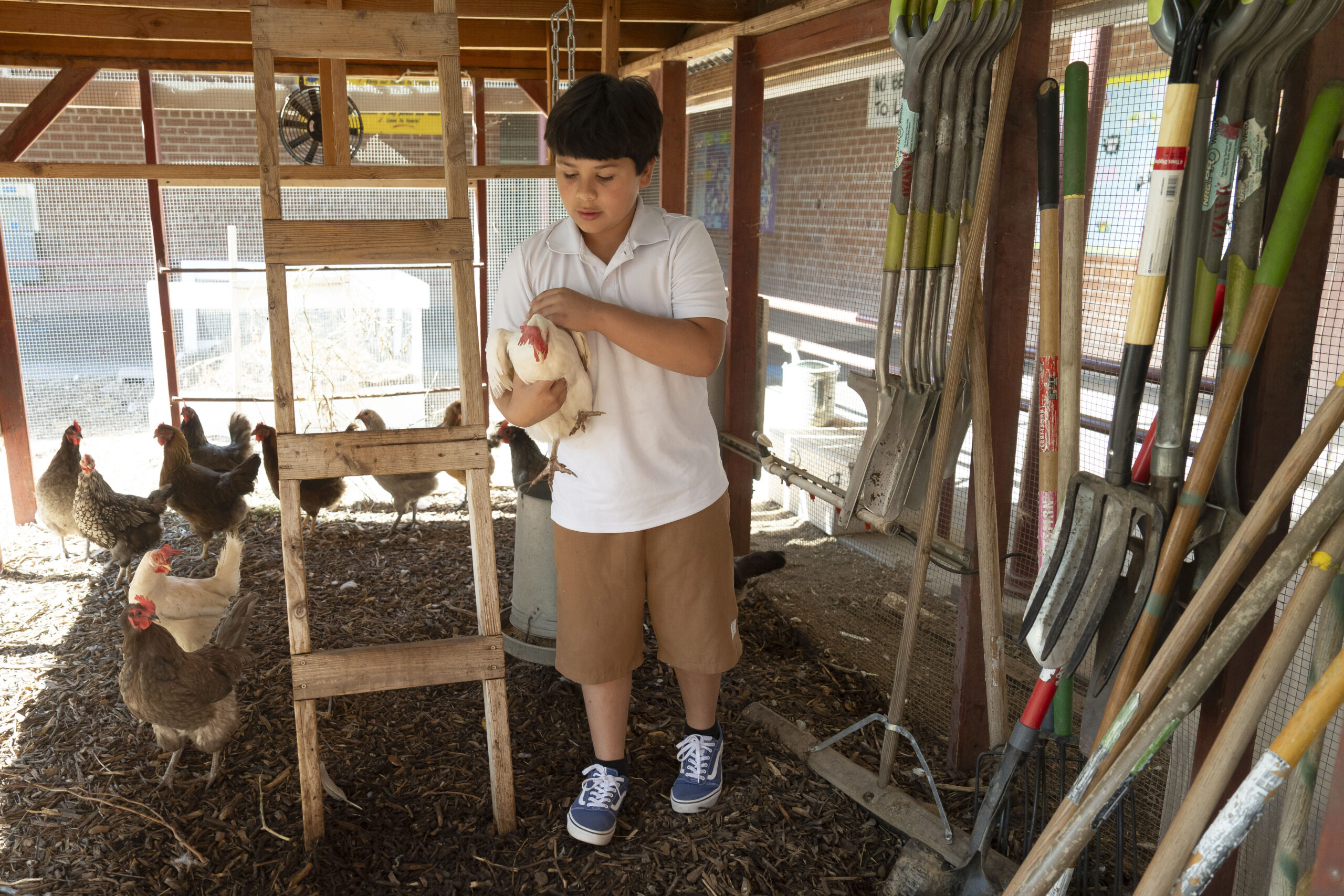
Manzo Elementary student Glenn Brockman holds a chicken in the school’s chicken coop.
Copyright 2025 Capital & Main.
All photos by Rebecca Noble.


 The SlickNovember 14, 2025
The SlickNovember 14, 2025
 Latest NewsNovember 19, 2025
Latest NewsNovember 19, 2025
 Column - State of InequalityNovember 13, 2025
Column - State of InequalityNovember 13, 2025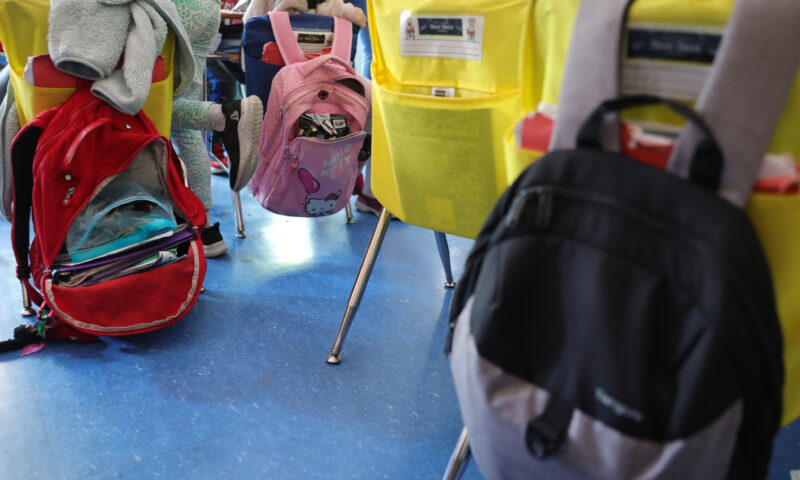
 Latest NewsNovember 18, 2025
Latest NewsNovember 18, 2025
 The SlickNovember 18, 2025
The SlickNovember 18, 2025
 Latest NewsNovember 17, 2025
Latest NewsNovember 17, 2025
 Column - State of InequalityNovember 21, 2025
Column - State of InequalityNovember 21, 2025
 StrandedNovember 25, 2025
StrandedNovember 25, 2025






